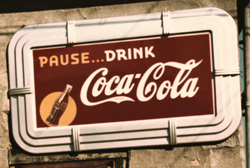Your Marketing Toolbox: Advertising

Advertising – an important component of
your marketing toolbox.
We’ve talked about the importance of integrated marketing – tying all of your tactics together under one unified strategy. But how do you know you’ve chosen the right tactics in the first place?
Different marketing tools come with different strengths and weaknesses, and different price tags, too. You have to strike the right balance between staying on budget and choosing the best tools to reach your objectives. So in this blog series we’ll break down the most common marketing tactics and discuss how, where and why (or why not) to use them. First up: Advertising.
We’re all familiar with advertising. It’s everywhere – television, radio, newspapers and magazines, outdoors and even inside public restrooms. (We’ll cover online advertising later.) It makes us laugh, think, sometimes groan and – most importantly – crack open our wallets.
Advertising can generate leads and direct sales (Act Now!), though it’s just as often used to build brand awareness or rejigger a company’s image. There are few better ways to announce a new product or service. Yet big corporations like Coke may spend millions every year even when they have nothing new to sell.

No company has been as successful as Coco-Cola in building positive brand awareness through advertising.
Research suggests businesses are spending less on traditional advertising and reallocating budgets to online marketing. But that also means you’ll find less competition in traditional media outlets. And when it’s done right, people pay attention.
That’s why advertising still holds an important position in many marketing plans. Next we’ll look at some pros and cons to help you decide if it’s right for your next campaign.
Pros of Advertising
With advertising, you have complete control of the message. You decide when and where it will appear, unlike PR efforts which are subject to the whims of editors and publishers.
Traditional advertising can also reach more people in more places than newer forms of marketing because it doesn’t require active participation, like social media or websites in which your customers must actively engage and interact with your sales message. Print advertising is a particularly good way to target niche markets.
And there’s no doubting the power of a truly creative advertising campaign. Remember Old Spice? The company revived its outdated brand with a series of clever commercials featuring “The Man Your Man Could Smell Like.”
Cons of Advertising
Here’s the bad news: advertising will cost you. It’s expensive relative to most other forms of marketing. Media outlets can be somewhat capricious when it comes to setting ad rates, though most will cut deals below the listed rate.
No matter where it appears, advertising also requires plenty of repetition. An old advertising rule of thumb says that viewers must read or see your ad seven times before it makes an impression. One or two ads, no matter how well targeted, won’t make an impact in a cluttered marketplace.
Lastly, unless your ad is designed to generate leads and direct sales, it can be difficult to measure your return on investment. As retail tycoon John Wanamaker once quipped: “Half the money I spend on advertising is wasted. The trouble is I don’t know which half.”
Tips to Get More from Your Advertising
If you decide to advertise (or more likely when), here are a few tips to help you get the most from this tactic:
- Choose media outlets carefully. Does the outlet appeal to your target demographic? How many people will it reach? Is it aligned with your brand, goals and strategy? All things considered, is it the most cost-effective option?
- Negotiate ad rates. Factors like competing outlets, ad placement, the size of your business, the time an ad runs and how often it runs can all be used to leverage lower rates. Don’t be afraid to haggle.
- Make it creative. Effective advertising relies on creativity more than the other tactics we’ll discuss. If it doesn’t make a dent in the consumer’s consciousness, great ad placement won’t mean much.
- Include a response mechanism. You may want to ask your audience to take some action that helps you gauge the ad’s effectiveness. For example, calling a particular toll-free phone number, visiting a specific web page for more information, or entering a unique code – anything you can use to track responses.
How have you used advertising in your marketing campaigns? Is it currently part of your marketing plan? Share your story in the comments below.
Pingback: The Marketing Tool Box - Which Tactics Are Best For Aviation Businesses